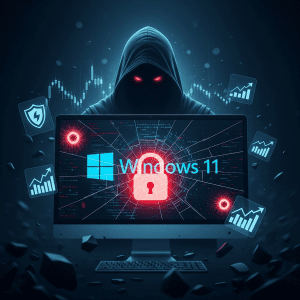Cybersecurity vendors revealed a 190% surge in fake Windows 11 download sites in Q3 2025, as Microsoft Corp. ($MSFT) faces backlash over forced upgrades. These fake Windows 11 download sites promise bypass tools but often host malware, putting retail users and enterprise networks at risk, sparking investor concern.
Fake Windows 11 Download Sites Jump 190% as Malware Risks Climb
In October 2025, threat intelligence firm Kaspersky reported the number of domains mimicking Microsoft Corp. ($MSFT) Windows 11 upgrade portals spiked to over 6,000, a 190% rise from Q2’s 2,066, according to their public threat report dated October 20. Malwarebytes Labs also detected a 150% increase in blocked malicious downloads directly linked to search ads targeting “Windows 11 bypass” queries. Microsoft confirmed in a September 2025 security advisory that at least three major ransomware families were traced to fake upgrade utilities, highlighting direct operational risk. These bypass tools usually promise users an unauthorized upgrade path but covertly deliver infostealers or ransomware payloads, with remediation costs now exceeding $9,100 per incident for small businesses per CyberEdge Group’s 2025 Cyberthreat Defense Report.
Why Cybersecurity Sector Volatility Increases Amid Fake Upgrade Surge
The proliferation of fake Windows 11 download sites is spurring volatility across the broader cybersecurity sector. Security software stocks have posted wild swings in late Q3 2025: CrowdStrike Holdings ($CRWD) jumped 4.6% on October 12 after issuing positive guidance tied to increased endpoint protection demand, while NortonLifeLock ($NLOK) dipped by 2.1% following concerns over consumer market saturation. Gartner’s mid-2025 Security Spending Analysis estimates global endpoint security spending will reach $19.6 billion in 2025, up from $17.2 billion in 2024, underpinned by enterprise fears of ransomware stemming from OS-related threats. This wave of attacks—fueled by fake download campaigns—reflects a wider trend of leveraging tech upgrades as attack vectors, a dynamic noted in multiple stock market analysis reports from mid-2025.
Portfolio Moves: How Investors Can Manage Cybersecurity Exposure Now
For investors examining their exposure, the risks from fake Windows 11 download sites warrant careful sector positioning. Technology-heavy portfolios are vulnerable to operational disruptions, especially those with significant small-cap IT or managed service provider holdings. Cybersecurity stocks such as Palo Alto Networks ($PANW) and SentintelOne ($S) have seen above-average trading volumes—Palo Alto’s 30-day average rose to 4.2 million shares in October, up from 2.9 million in July (Yahoo Finance data). Defensive allocations into diversified cybersecurity ETFs can hedge some risk, while scrutinizing vendor reliance on Microsoft-driven upgrade cycles may reveal short-term vulnerabilities. Traders should also monitor upcoming enterprise adoption schedules, as these are potential catalysts for further security vendor outperformance. For more insights, see latest financial news and investment strategy resources.
What Analysts Expect Next For Microsoft and Cybersecurity Stocks
Market consensus suggests Microsoft Corp. ($MSFT) is under increased scrutiny as user frustration over Windows 11 requirements feeds cyber risk, especially among small and mid-sized businesses. Industry analysts observe that aggressive upgrade enforcement could drive additional spending on endpoint security and backup services through 2026. According to IDC’s August 2025 Security Outlook, enterprises are likely to prioritize spending on detection and response tools, favoring vendors with multi-OS coverage and rapid update cycles.
Fake Windows 11 Download Sites Signal Persistent Risk for 2025 Investors
The rapid rise of fake Windows 11 download sites underscores the evolving danger of social engineering campaigns tied to OS upgrades. Investors should closely monitor both Microsoft Corp. ($MSFT) policy shifts and cybersecurity sector momentum, as the ongoing threat landscape is likely to sustain volatility. As demand for protective software remains high, positioning portfolios with an eye on digital risk mitigation offers a forward-looking edge in 2025.
Tags: fake Windows 11 download sites, MSFT, cybersecurity, ransomware, technology stocks

